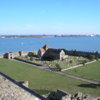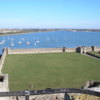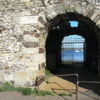Portchester Castle, Hampshire
Title
Portchester Castle, Hampshire
Subject
Archaeology
Description
The site of Portchester Castle has a very long history. It had its beginnings as a Roman shore-fort, and was built in the late third century A.D. The walls surrounding the castle and bailey today are the original Roman walls, and it is regarded as the best preserved Roman fort in Northern Europe. The site was re-occupied during the Anglo-Saxon period. The modern name Portchester is of Anglo-Saxon origin. In 904 A.D. Portchester came under the possession of King Alfred's successor, Edward the Elder (899-924), who repaired and used the fort as a burgh to protect the area against Viking attacks. Archaeological excavation within the Roman walls has discovered the remains of a tenth century Anglo-Saxon hall and tower. The only Anglo-Saxon additions to Portchester remaining today are found in the Watergate, much of which dates to the late Saxon period. The site was significant throughout the Middle Ages, and in the early twelfth-century the castle was first constructed within the Roman walls. The church within the grounds was also built about the same time (probably c. 1130). By the mid twelfth century Portchester became a possession of the Crown, and was often a royal residence during the medieval period. The castle also served as a prison during the Napoleonic wars.
Creator
Kelly A. Kilpatrick
Date
Roman, Anglo-Saxon, Norman, Medieval
Language
English
Files
Citation
Kelly A. Kilpatrick, “Portchester Castle, Hampshire,” Woruldhord, accessed April 24, 2024, http://poppy.nsms.ox.ac.uk/woruldhord/items/show/176.



